Abstract
A review of the health effects of relative humidity in indoor environments suggests that relative humidity can affect the incidence of respiratory infections and allergies. Experimental studies on airborne-transmitted infectious bacteria and viruses have shown that the survival or infectivity of these organisms is minimized by exposure to relative humidities between 40 and 70%. Nine epidemiological studies examined the relationship between the number of respiratory infections or absenteeism and the relative humidity of the office, residence, or school. The incidence of absenteeism or respiratory infections was found to be lower among people working or living in environments with mid-range versus low or high relative humidities. The indoor size of allergenic mite and fungal populations is directly dependent upon the relative humidity. Mite populations are minimized when the relative humidity is below 50% and reach a maximum size at 80% relative humidity. Most species of fungi cannot grow unless the relative humidity exceeds 60%. Relative humidity also affects the rate of offgassing of formaldehyde from indoor building materials, the rate of formation of acids and salts from sulfur and nitrogen dioxide, and the rate of formation of ozone. The influence of relative humidity on the abundance of allergens, pathogens, and noxious chemicals suggests that indoor relative humidity levels should be considered as a factor of indoor air quality. The majority of adverse health effects caused by relative humidity would be minimized by maintaining indoor levels between 40 and 60%. This would require humidification during winter in areas with cold winter climates. Humidification should preferably use evaporative or steam humidifiers, as cool mist humidifiers can disseminate aerosols contaminated with allergens.
Full text
PDF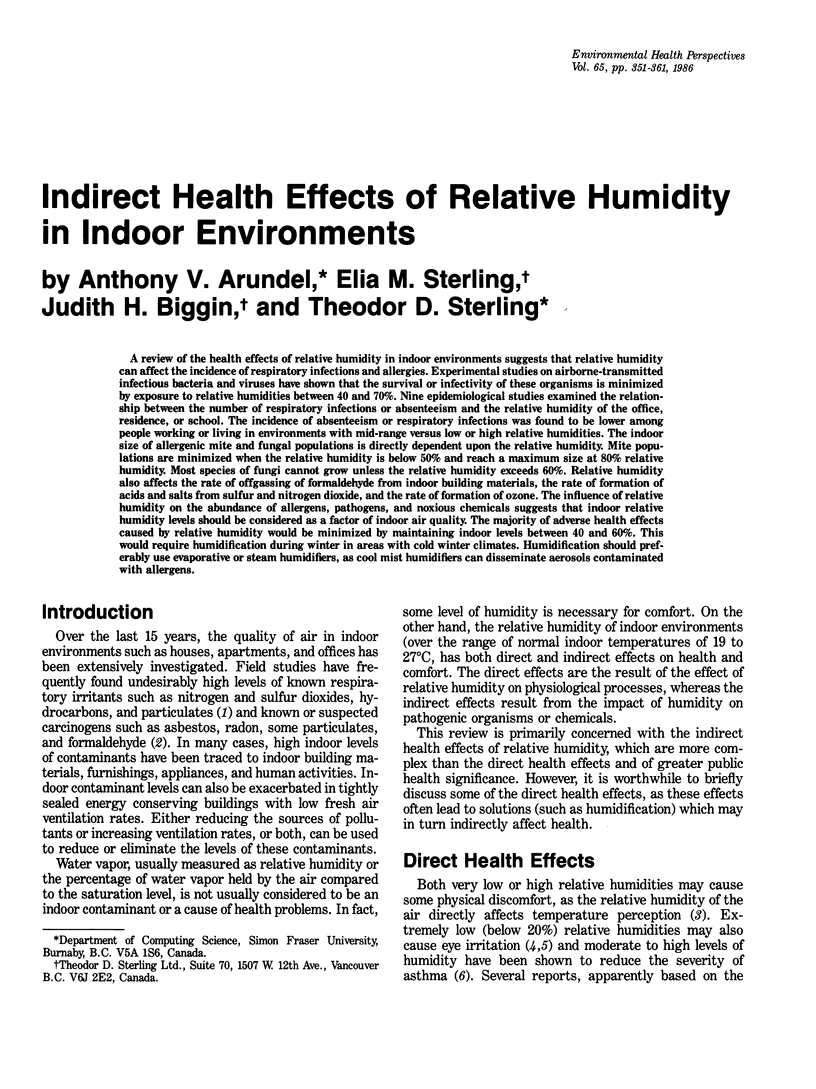
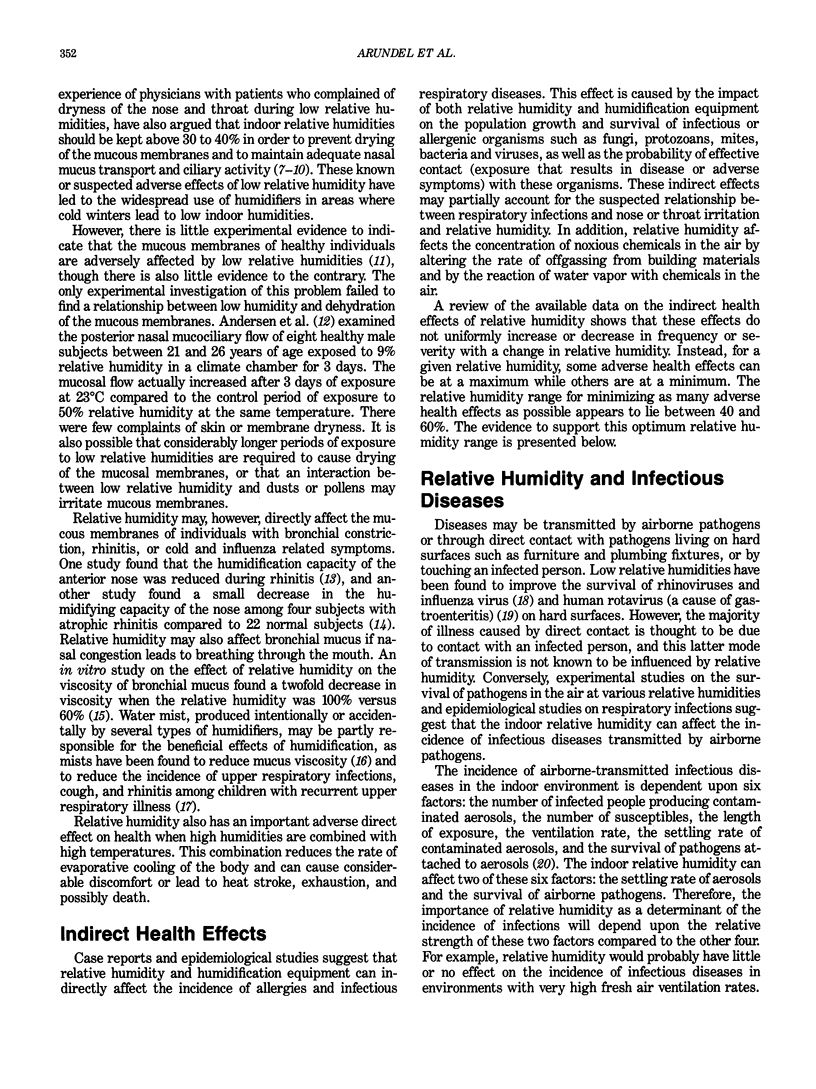
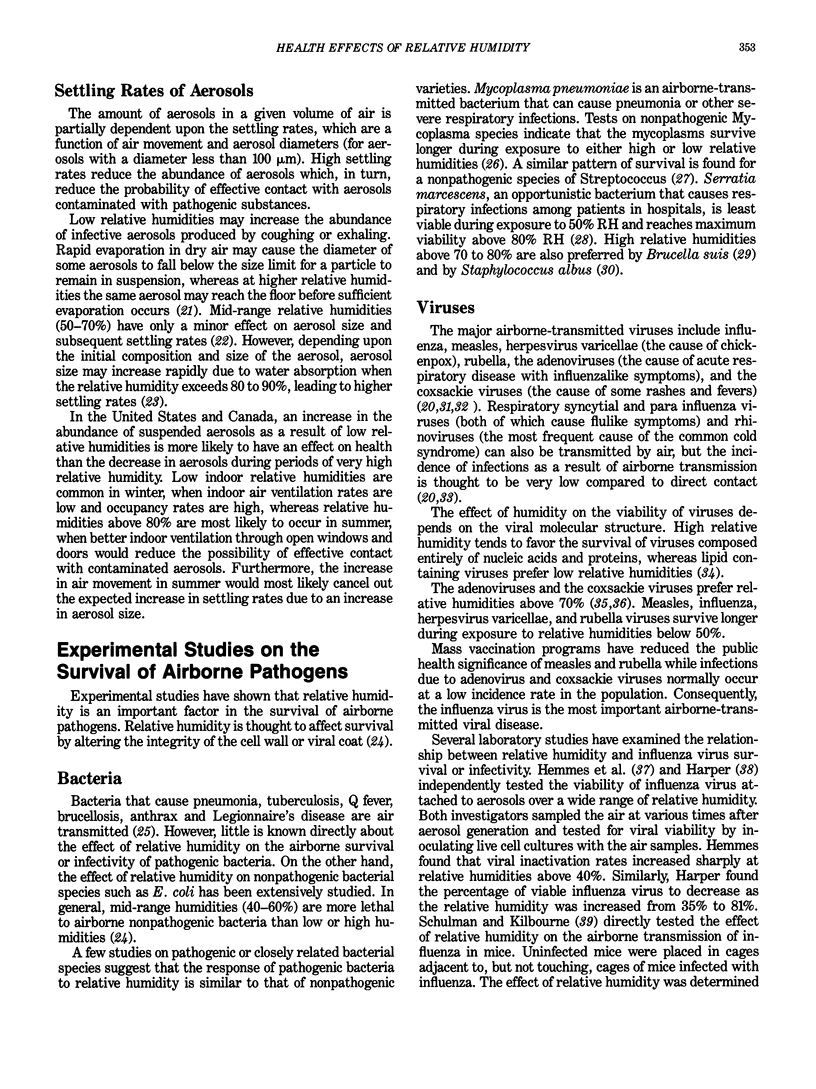
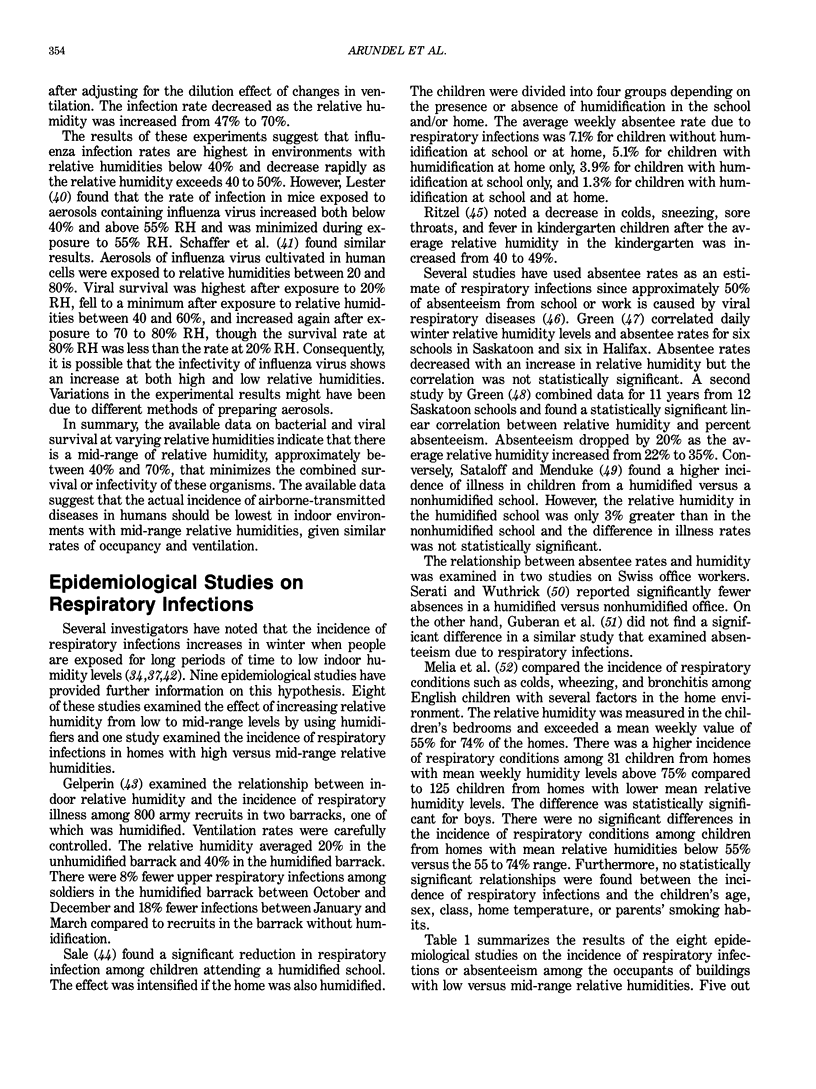
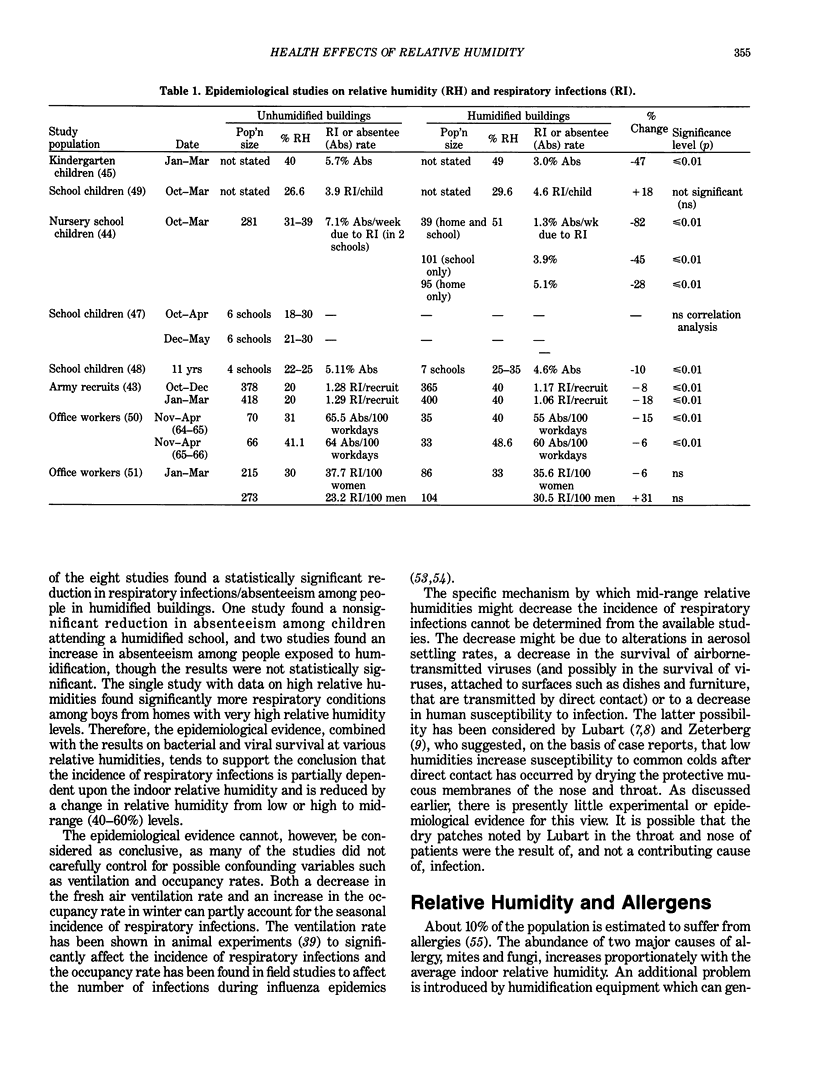
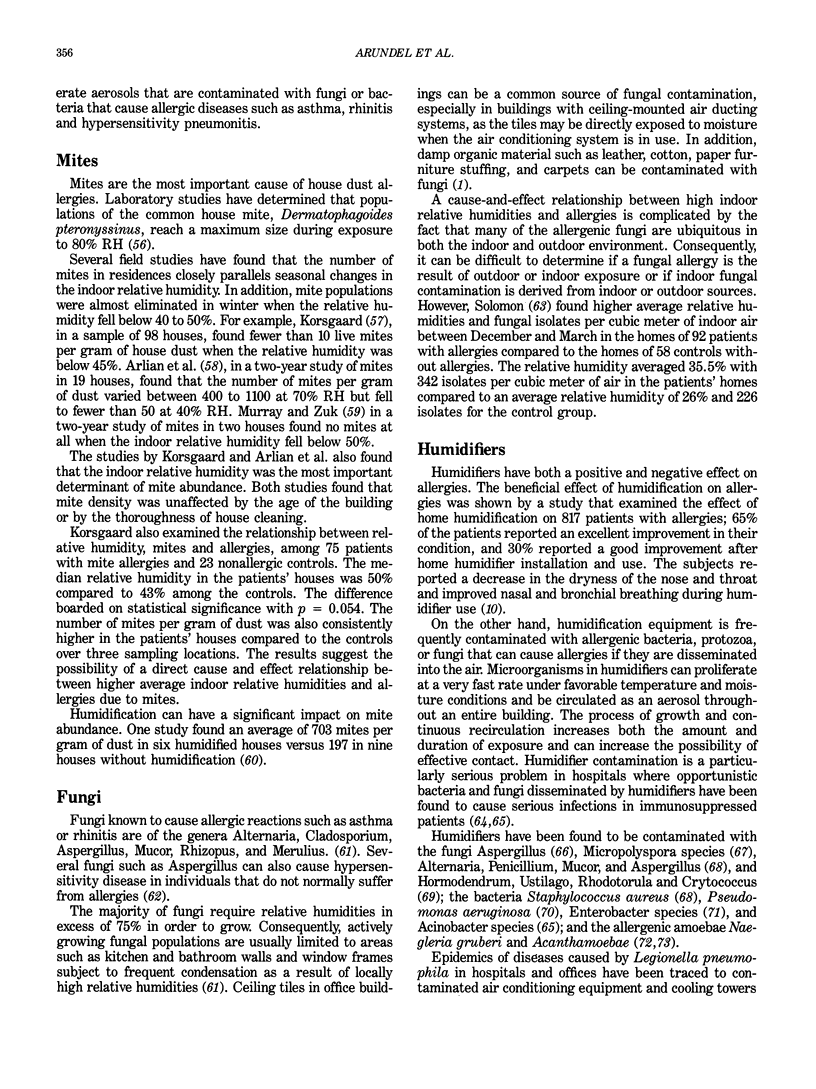
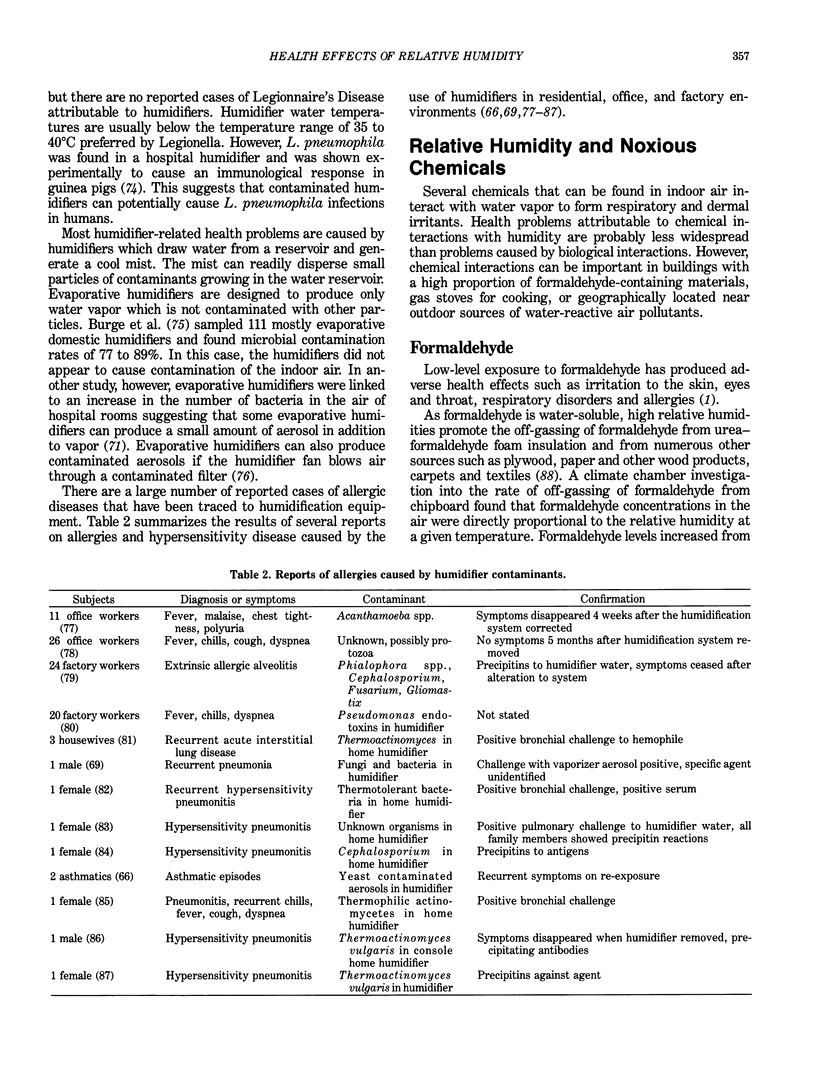
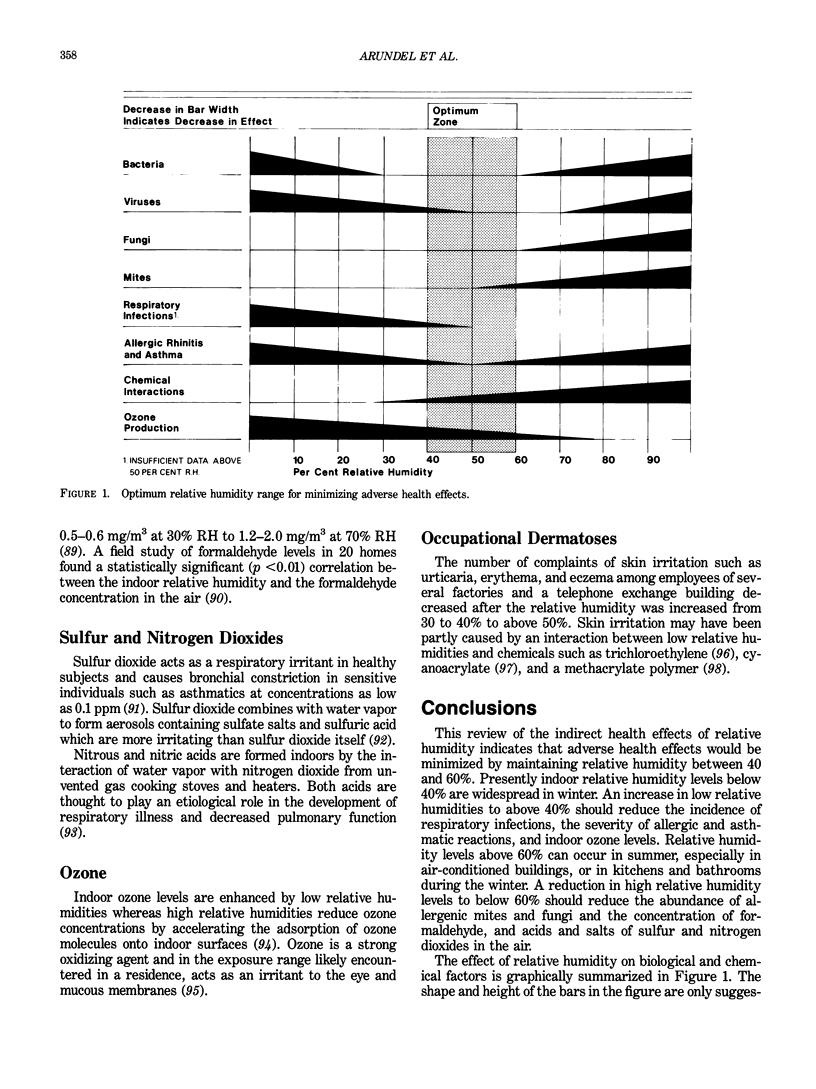
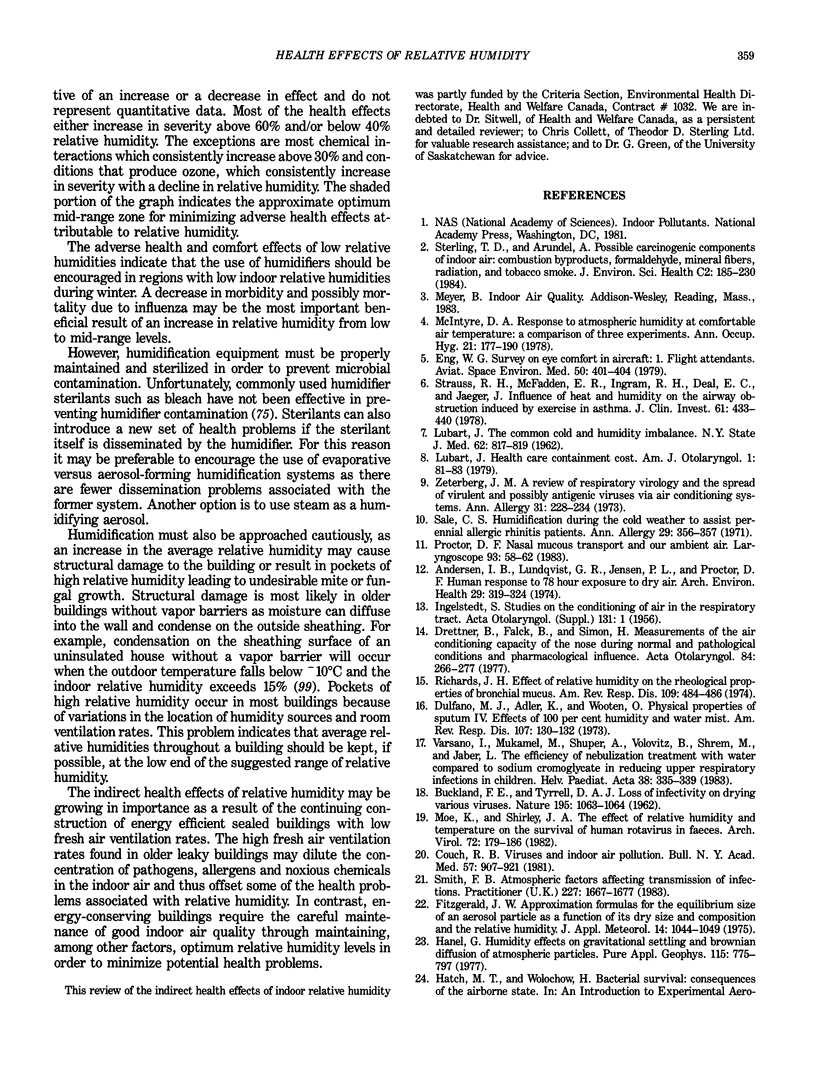
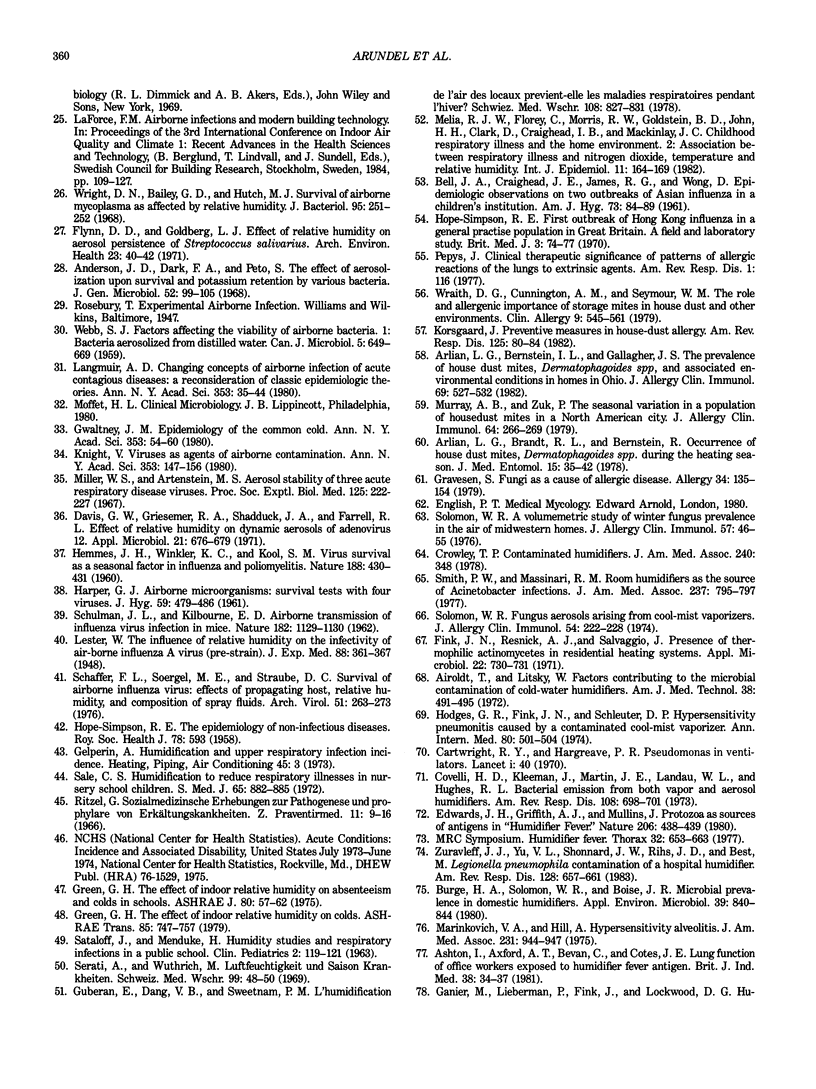
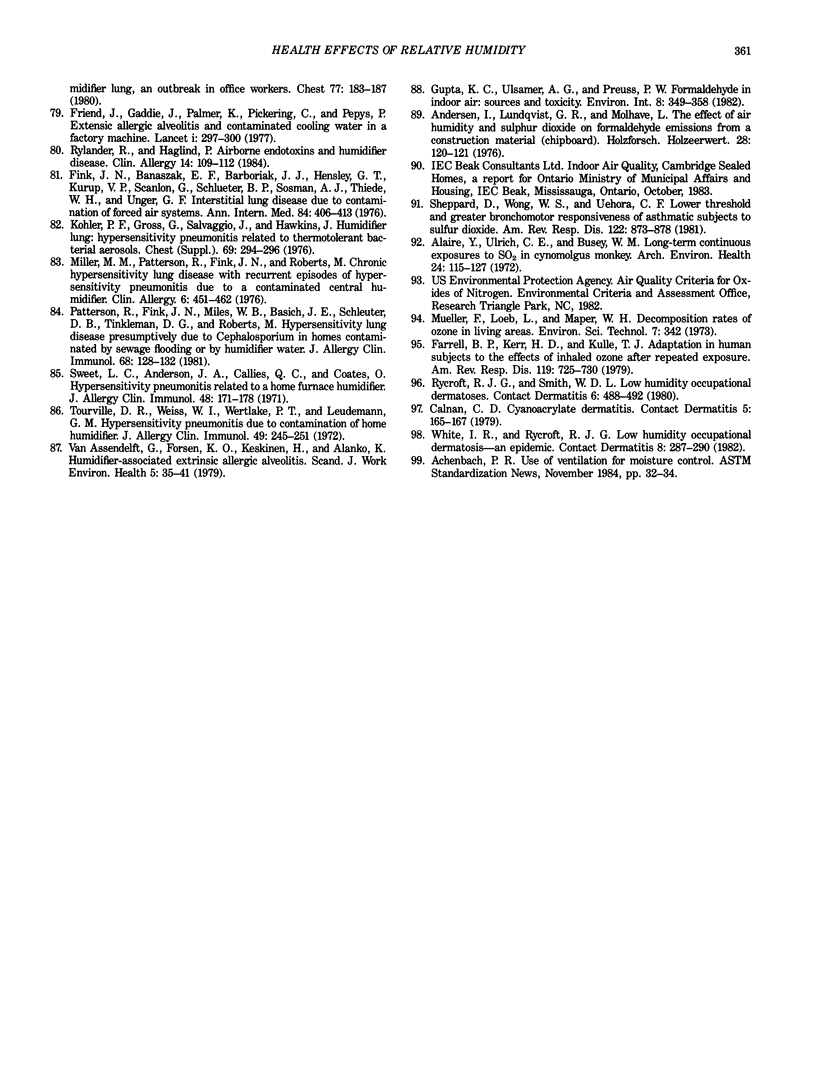
Selected References
These references are in PubMed. This may not be the complete list of references from this article.
- Airoldi T., Litsky W. Factors contributing to the microbial contamination of cold-water humidifiers. Am J Med Technol. 1972 Dec;38(12):491–495. [PubMed] [Google Scholar]
- Alarie Y., Ulrich C. E., Busey W. M., Krumm A. A., MacFarland H. N. Long-term continuous exposure to sulfur dioxide in cynomolgus monkeys. Arch Environ Health. 1972 Feb;24(2):115–128. doi: 10.1080/00039896.1972.10666060. [DOI] [PubMed] [Google Scholar]
- Andersen I., Lundqvist G. R., Jensen P. L., Proctor D. F. Human response to 78-hour exposure to dry air. Arch Environ Health. 1974 Dec;29(6):319–324. doi: 10.1080/00039896.1974.10666606. [DOI] [PubMed] [Google Scholar]
- Arlian L. G., Bernstein I. L., Gallagher J. S. The prevalence of house dust mites, Dermatophagoides spp, and associated environmental conditions in homes in Ohio. J Allergy Clin Immunol. 1982 Jun;69(6):527–532. doi: 10.1016/0091-6749(82)90178-6. [DOI] [PubMed] [Google Scholar]
- Arlian L. G., Brandt R. L., Bernstein R. Occurrence of house dust mites, Dermatophagoides spp. (Acari: Pyroglyphidae), during the heating season. J Med Entomol. 1978 Nov 7;15(1):35–42. doi: 10.1093/jmedent/15.1.35. [DOI] [PubMed] [Google Scholar]
- Ashton I., Axford A. T., Bevan C., Cotes J. E. Lung function of office workers exposed to humidifier fever antigen. Br J Ind Med. 1981 Feb;38(1):34–37. doi: 10.1136/oem.38.1.34. [DOI] [PMC free article] [PubMed] [Google Scholar]
- BUCKLAND F. E., TYRRELL D. A. Loss of infectivity on drying various viruses. Nature. 1962 Sep 15;195:1063–1064. doi: 10.1038/1951063a0. [DOI] [PubMed] [Google Scholar]
- Burge H. A., Solomon W. R., Boise J. R. Microbial prevalence in domestic humidifiers. Appl Environ Microbiol. 1980 Apr;39(4):840–844. doi: 10.1128/aem.39.4.840-844.1980. [DOI] [PMC free article] [PubMed] [Google Scholar]
- Calnan C. D. Cyanoacrylate dermatitis. Contact Dermatitis. 1979 May;5(3):165–167. doi: 10.1111/j.1600-0536.1979.tb04830.x. [DOI] [PubMed] [Google Scholar]
- Cartwright R. Y., Hargrave P. R. Pseudomonas in ventilators. Lancet. 1970 Jan 3;1(7636):40–40. doi: 10.1016/s0140-6736(70)90553-2. [DOI] [PubMed] [Google Scholar]
- Couch R. B. Viruses and indoor air pollution. Bull N Y Acad Med. 1981 Dec;57(10):907–921. [PMC free article] [PubMed] [Google Scholar]
- Covelli H. D., Kleeman J., Martin J. E., Landau W. L., Hughes R. L. Bacterial emission from both vapor and aerosol humidifiers. Am Rev Respir Dis. 1973 Sep;108(3):698–701. doi: 10.1164/arrd.1973.108.3.698. [DOI] [PubMed] [Google Scholar]
- Crowley T. P. Contaminated humidifiers. JAMA. 1978 Jul 28;240(4):348–348. doi: 10.1001/jama.1978.03290040026015. [DOI] [PubMed] [Google Scholar]
- Davis G. W., Griesemer R. A., Shadduck J. A., Farrell R. L. Effect of relative humidity on dynamic aerosols of adenovirus 12. Appl Microbiol. 1971 Apr;21(4):676–679. doi: 10.1128/am.21.4.676-679.1971. [DOI] [PMC free article] [PubMed] [Google Scholar]
- Drettner B., Falck B., Simon H. Measurements of the air conditioning capacity of the nose during normal and pathological conditions and pharmacological influence. Acta Otolaryngol. 1977 Sep-Oct;84(3-4):266–277. doi: 10.3109/00016487709123966. [DOI] [PubMed] [Google Scholar]
- Dulfano M. J., Adler K., Wooten O. Physical properties of sputum. IV. Effects of 100 per cent humidity and water mist. Am Rev Respir Dis. 1973 Jan;107(1):130–132. doi: 10.1164/arrd.1973.107.1.130. [DOI] [PubMed] [Google Scholar]
- Eng W. G. Survey on eye comfort in aircraft: I. Flight attendants. Aviat Space Environ Med. 1979 Apr;50(4):401–404. [PubMed] [Google Scholar]
- Farrell B. P., Kerr H. D., Kulle T. J., Sauder L. R., Young J. L. Adaptation in human subjects to the effects of inhaled ozone after repeated exposure. Am Rev Respir Dis. 1979 May;119(5):725–730. doi: 10.1164/arrd.1979.119.5.725. [DOI] [PubMed] [Google Scholar]
- Fink J. N., Banaszak E. F., Barboriak J. J., Hensley G. T., Kurup V. P., Scanlon G. T., Schlueter D. P., Sosman A. J., Thiede W. H., Unger G. F. Interstital lung disease due to contamination of forced air systems. Ann Intern Med. 1976 Apr;84(4):406–413. doi: 10.7326/0003-4819-84-4-406. [DOI] [PubMed] [Google Scholar]
- Fink J. N., Resnick A. J., Salvaggio J. Presence of thermophilic acintomycetes in residential heating systems. Appl Microbiol. 1971 Oct;22(4):730–731. doi: 10.1128/am.22.4.730-731.1971. [DOI] [PMC free article] [PubMed] [Google Scholar]
- Flynn D. D., Goldberg L. J. Effect of relative humidity on aerosol persistence of Streptococcus salivarius. Arch Environ Health. 1971 Jul;23(1):40–42. doi: 10.1080/00039896.1971.10665952. [DOI] [PubMed] [Google Scholar]
- Gravesen S. Fungi as a cause of allergic disease. Allergy. 1979 Jun;34(3):135–154. doi: 10.1111/j.1398-9995.1979.tb01562.x. [DOI] [PubMed] [Google Scholar]
- Gubéran E., Dang V. B., Sweetnam P. M. L'humidification de l'air des locaux prévientelle les maladies respiratories pendant l'hiver? Une étude épidémiologique parmi 1321 employés de bureau. Schweiz Med Wochenschr. 1978 Jun 3;108(22):827–831. [PubMed] [Google Scholar]
- Gwaltney J. M., Jr Epidemiology of the common cold. Ann N Y Acad Sci. 1980;353:54–60. doi: 10.1111/j.1749-6632.1980.tb18905.x. [DOI] [PubMed] [Google Scholar]
- HARPER G. J. Airborne micro-organisms: survival tests with four viruses. J Hyg (Lond) 1961 Dec;59:479–486. doi: 10.1017/s0022172400039176. [DOI] [PMC free article] [PubMed] [Google Scholar]
- HEMMES J. H., WINKLER K. C., KOOL S. M. Virus survival as a seasonal factor in influenza and polimyelitis. Nature. 1960 Oct 29;188:430–431. doi: 10.1038/188430a0. [DOI] [PubMed] [Google Scholar]
- Hodges G. R., Fink J. N., Schlueter D. P. Hypersensitivity pneumonitis caused by a contaminated cool-mist vaporizer. Ann Intern Med. 1974 Apr;80(4):501–504. doi: 10.7326/0003-4819-80-4-501. [DOI] [PubMed] [Google Scholar]
- Hope-Simpson R. E. First outbreak of Hong Kong influenza in a general practice population in Great Britain. A field and laboratory study. Br Med J. 1970 Jul 11;3(5714):74–77. doi: 10.1136/bmj.3.5714.74. [DOI] [PMC free article] [PubMed] [Google Scholar]
- INGELSTEDT S. Studies on the conditioning of air in the respiratory tract. Acta Otolaryngol Suppl. 1956;131:1–80. [PubMed] [Google Scholar]
- Knight V. Viruses as agents of airborne contagion. Ann N Y Acad Sci. 1980;353:147–156. doi: 10.1111/j.1749-6632.1980.tb18917.x. [DOI] [PubMed] [Google Scholar]
- Kohler P. F., Gross G., Salvaggio J., Hawkins J. Humidifier lung: hypersensitivity pneumonitis related to thermotolerant bacterial aerosols. Chest. 1976 Feb;69(2 Suppl):294–296. [PubMed] [Google Scholar]
- Korsgaard J. Preventive measures in house-dust allergy. Am Rev Respir Dis. 1982 Jan;125(1):80–84. doi: 10.1164/arrd.1982.125.1.80. [DOI] [PubMed] [Google Scholar]
- LUBART J. The common cold and humidity imbalance. N Y State J Med. 1962 Mar 15;62:816–819. [PubMed] [Google Scholar]
- Langmuir A. D. Changing concepts of airborne infection of acute contagious diseases: a reconsideration of classic epidemiologic theories. Ann N Y Acad Sci. 1980;353:35–44. doi: 10.1111/j.1749-6632.1980.tb18903.x. [DOI] [PubMed] [Google Scholar]
- Lubart J. Health care cost containment. Am J Otolaryngol. 1979 Fall;1(1):81–83. doi: 10.1016/s0196-0709(79)80011-3. [DOI] [PubMed] [Google Scholar]
- MacIntyre D. A. Response to atmospheric humidity at comfortable air temperature: a comparison of three experiments. Ann Occup Hyg. 1978 Aug;21(2):177–190. doi: 10.1093/annhyg/21.2.177. [DOI] [PubMed] [Google Scholar]
- Marinkovich V. A., Hill A. Hypersensitivity alveolitis. JAMA. 1975 Mar 3;231(9):944–947. [PubMed] [Google Scholar]
- Melia R. J., Florey C. du V., Morris R. W., Goldstein B. D., John H. H., Clark D., Craighead I. B., Mackinlay J. C. Childhood respiratory illness and the home environment. II. Association between respiratory illness and nitrogen dioxide, temperature and relative humidity. Int J Epidemiol. 1982 Jun;11(2):164–169. doi: 10.1093/ije/11.2.164. [DOI] [PubMed] [Google Scholar]
- Miller M. M., Patterson R., Fink J. N., Roberts M. Chronic hypersensitivity lung disease with recurrent episodes of hypersensitivity pneumonitis due to a contaminated central humidifer. Clin Allergy. 1976 Sep;6(5):451–462. doi: 10.1111/j.1365-2222.1976.tb01929.x. [DOI] [PubMed] [Google Scholar]
- Miller W. S., Artenstein M. S. Aerosol stability of three acute respiratory disease viruses. Proc Soc Exp Biol Med. 1967 May;125(1):222–227. doi: 10.3181/00379727-125-32054. [DOI] [PubMed] [Google Scholar]
- Moe K., Shirley J. A. The effects of relative humidity and temperature on the survival of human rotavirus in faeces. Arch Virol. 1982;72(3):179–186. doi: 10.1007/BF01348963. [DOI] [PubMed] [Google Scholar]
- Murray A. B., Zuk P. The seasonal variation in a population of house dust mites in a North American city. J Allergy Clin Immunol. 1979 Oct;64(4):266–269. doi: 10.1016/0091-6749(79)90142-8. [DOI] [PubMed] [Google Scholar]
- Patterson R., Fink J. N., Miles W. B., Basich J. E., Schleuter D. B., Tinkelman D. G., Roberts M. Hypersensitivity lung disease presumptively due to Cephalosporium in homes contaminated by sewage flooding or by humidifier water. J Allergy Clin Immunol. 1981 Aug;68(2):128–132. doi: 10.1016/0091-6749(81)90171-8. [DOI] [PubMed] [Google Scholar]
- Proctor D. F. Nasal mucous transport and our ambient air. Laryngoscope. 1983 Jan;93(1):58–62. doi: 10.1288/00005537-198301000-00011. [DOI] [PubMed] [Google Scholar]
- Richards J. H. Effect of relative humidity on the rheologic properties of bronchial mucus. Am Rev Respir Dis. 1974 Apr;109(4):484–486. doi: 10.1164/arrd.1974.109.4.484. [DOI] [PubMed] [Google Scholar]
- Rycroft R. J., Smith W. D. Low humidity occupational dermatoses. Contact Dermatitis. 1980 Dec;6(7):488–492. doi: 10.1111/j.1600-0536.1980.tb05572.x. [DOI] [PubMed] [Google Scholar]
- Rylander R., Haglind P. Airborne endotoxins and humidifier disease. Clin Allergy. 1984 Jan;14(1):109–112. doi: 10.1111/j.1365-2222.1984.tb02197.x. [DOI] [PubMed] [Google Scholar]
- SATALOFF J., MENDUKE H. Humidity studies and respiratory infections in a public school. Clin Pediatr (Phila) 1963 Mar;2:119–121. doi: 10.1177/000992286300200304. [DOI] [PubMed] [Google Scholar]
- SCHULMAN J. L., KILBOURNE E. D. Airborne transmission of influenza virus infection in mice. Nature. 1962 Sep 15;195:1129–1130. doi: 10.1038/1951129a0. [DOI] [PubMed] [Google Scholar]
- SIMPSON R. E. H. Common upper respiratory diseases. R Soc Health J. 1958 Sep-Oct;78(5):593–599. doi: 10.1177/146642405807800521. [DOI] [PubMed] [Google Scholar]
- Sale C. S. Humidification during the cold weather to assist perennial allergic rhinitis patients. Ann Allergy. 1971 Jul;29(7):356–357. [PubMed] [Google Scholar]
- Sale C. S. Humidification to reduce respiratory illnesses in nursery school children. South Med J. 1972 Jul;65(7):882–885. doi: 10.1097/00007611-197207000-00024. [DOI] [PubMed] [Google Scholar]
- Schaffer F. L., Soergel M. E., Straube D. C. Survival of airborne influenza virus: effects of propagating host, relative humidity, and composition of spray fluids. Arch Virol. 1976;51(4):263–273. doi: 10.1007/BF01317930. [DOI] [PubMed] [Google Scholar]
- Serati A., Wüthrich M. Luftfeuchtigkeit und Saisonkrankheiten. Schweiz Med Wochenschr. 1969 Jan 11;99(2):48–50. [PubMed] [Google Scholar]
- Sheppard D., Wong W. S., Uehara C. F., Nadel J. A., Boushey H. A. Lower threshold and greater bronchomotor responsiveness of asthmatic subjects to sulfur dioxide. Am Rev Respir Dis. 1980 Dec;122(6):873–878. doi: 10.1164/arrd.1980.122.6.873. [DOI] [PubMed] [Google Scholar]
- Smith P. W., Massanari R. M. Room humidifiers as the source of Acinetobacter infections. JAMA. 1977 Feb 21;237(8):795–797. [PubMed] [Google Scholar]
- Solomon W. R. A volumetric study of winter fungus prevalence in the air of midwestern homes. J Allergy Clin Immunol. 1976 Jan;57(1):46–55. doi: 10.1016/0091-6749(76)90078-6. [DOI] [PubMed] [Google Scholar]
- Solomon W. R. Fungus aerosols arising from cold-mist vaporizers. J Allergy Clin Immunol. 1974 Oct;54(4):222–228. doi: 10.1016/0091-6749(74)90064-5. [DOI] [PubMed] [Google Scholar]
- Strauss R. H., McFadden E. R., Jr, Ingram R. H., Jr, Deal E. C., Jr, Jaeger J. J. Influence of heat and humidity on the airway obstruction induced by exercise in asthma. J Clin Invest. 1978 Feb;61(2):433–440. doi: 10.1172/JCI108954. [DOI] [PMC free article] [PubMed] [Google Scholar]
- Sweet L. C., Anderson J. A., Callies Q. C., Coates E. O., Jr Hypersensitivity pneumonitis related to a home furnace humidfier. J Allergy Clin Immunol. 1971 Sep;48(3):171–178. doi: 10.1016/0091-6749(71)90013-3. [DOI] [PubMed] [Google Scholar]
- Tourville D. R., Weiss W. I., Wertlake P. T., Leudemann G. M. Hypersensitivity pneumonitis due to contamination of home humidifier. J Allergy Clin Immunol. 1972 Apr;49(4):245–251. doi: 10.1016/0091-6749(72)90087-5. [DOI] [PubMed] [Google Scholar]
- Varsano I., Mukamel M., Shuper A., Volovitz B., Shrem M., Jaber L. The efficiency of nebulization treatment with water compared to sodium cromoglycate in reducing upper respiratory infections in children. Helv Paediatr Acta. 1983 Oct;38(4):335–339. [PubMed] [Google Scholar]
- White I. R., Rycroft R. J. Low humidity occupational dermatosis - an epidemic. Contact Dermatitis. 1982 Sep;8(5):287–290. doi: 10.1111/j.1600-0536.1982.tb04232.x. [DOI] [PubMed] [Google Scholar]
- Wraith D. G., Cunnington A. M., Seymour W. M. The role and allergenic importance of storage mites in house dust and other environments. Clin Allergy. 1979 Nov;9(6):545–561. doi: 10.1111/j.1365-2222.1979.tb00478.x. [DOI] [PubMed] [Google Scholar]
- Wright D. N., Bailey G. D., Hatch M. T. Survival of airborne Mycoplasma as affected by relative humidity. J Bacteriol. 1968 Jan;95(1):251–252. doi: 10.1128/jb.95.1.251-252.1968. [DOI] [PMC free article] [PubMed] [Google Scholar]
- Zeterberg J. M. A review of respiratory virology and the spread of virulent and possibly antigenic viruses via air conditioning systems. I. Ann Allergy. 1973 May;31(5):228–234. [PubMed] [Google Scholar]
- Zuravleff J. J., Yu V. L., Shonnard J. W., Rihs J. D., Best M. Legionella pneumophila contamination of a hospital humidifier. Demonstration of aerosol transmission and subsequent subclinical infection in exposed guinea pigs. Am Rev Respir Dis. 1983 Oct;128(4):657–661. doi: 10.1164/arrd.1983.128.4.657. [DOI] [PubMed] [Google Scholar]
- van Assendelft A., Forsén K. O., Keskinen H., Alanko K. Humidifier-associated extrinsic allergic alveolitis. Scand J Work Environ Health. 1979 Mar;5(1):35–41. doi: 10.5271/sjweh.2673. [DOI] [PubMed] [Google Scholar]


